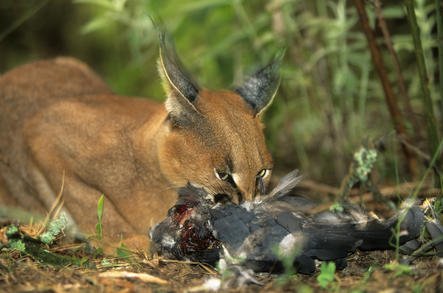
Let’s dig into what makes the caracal such a remarkable hunter and what fuels its energy for those daring chases. Understanding their diet and hunting methods not only sheds light on their survival skills but also highlights the delicate balance of ecosystems they inhabit. So grab that coffee, and let’s explore the world of the caracal!
What Do Caracals Eat?
Caracals are obligate carnivores, which means their diet consists almost entirely of meat. They are opportunistic hunters and are known to be quite versatile in their food choices. In the wild, they primarily feast on small to medium-sized mammals, birds, and even some reptiles. Here’s a closer look at what they typically munch on:
- Rodents: Mice and rats are common targets for caracals, especially since they’re often found in abundance.
- Birds: Caracals have impressive agility and can leap high into the air to snag birds right out of the sky.
- Antelopes: While it sounds ambitious, caracals can take down small antelope species, particularly the young or weaker individuals.
- Lagomorphs: Rabbits and hares are also a significant part of a caracal’s diet, providing a quick source of energy after a hunt.
Honestly, caracals can adjust their diet based on their environment. For instance, in arid regions where water is scarce, they might opt for animals that are easier to catch and have higher water content.
Hunting Techniques of the Caracal
The caracal is not just a pretty face; it’s a master hunter equipped with skills and techniques that make it a formidable predator. One of their most notable abilities is their incredible leaping power. Caracals can jump up to 10 feet in the air to catch birds mid-flight! Here’s a breakdown of their primary hunting strategies:
- Stalking: Caracals often employ a stealthy approach, quietly creeping up on their prey while using the cover of bushes and grass to remain undetected.
- Ambush: Once they get close enough, they’ll crouch low to the ground and wait for the perfect moment to spring into action, launching themselves at their unsuspecting target.
- High Jump: When hunting birds, their ability to leap allows them to surprise their prey from below, making it difficult for the birds to escape.
You might be wondering how they can manage these jumps. Caracals have strong, muscular hind legs that provide the necessary power for such impressive leaps, making them highly effective hunters.
Adaptations for Hunting
Caracals have several adaptations that enhance their hunting abilities. Let’s explore some of these fascinating features:
- Tufted Ears: Their distinctive ear tufts may help in communication and in locating sounds, which is crucial when stalking prey.
- Camouflage: With a coat that blends seamlessly into their surroundings, caracals are great at hiding, making it easier to approach prey without being noticed.
- Agility: Their lean body and long legs allow for quick bursts of speed and agility, essential for chasing down prey or making sharp turns while in pursuit.
Let me explain how these traits work together. When a caracal spots its target, its keen sense of hearing helps it track movements, while its agility ensures it can quickly change direction. This combination is what makes caracals such efficient hunters.
Hunting in Groups vs. Solitary Hunting
While caracals are predominantly solitary hunters, they sometimes band together for specific hunting purposes. Here’s how this dynamic plays out:
- Solitary Hunting: Most often, caracals prefer to hunt alone. This allows them to be stealthy and avoid competition. Each cat relies on its skills to track and hunt their prey, which can be a more efficient process without the need for cooperation.
- Group Hunting: Occasionally, especially among mothers and their young or closely related females, caracals may hunt together. This behavior can help them tackle larger prey or share the burden of caring for kittens.
Here’s the thing: hunting in groups can increase success rates, but it also comes with challenges. Competition for food can arise, so it’s a balancing act for these cats.
Impact of Habitat on Diet and Hunting
The habitat where caracals live greatly influences their diet and hunting strategies. These cats can thrive in diverse environments, including savannas, forests, and even mountainous regions. Here’s how different habitats shape their hunting experience:
- Open Plains: In open landscapes, caracals rely on their speed and agility to chase prey. Their camouflage is less effective here, so stealth becomes even more crucial.
- Wooded Areas: In forested habitats, caracals can use the cover of trees and underbrush to sneak up on animals, making ambush techniques more viable.
- Urban Areas: Surprisingly, caracals have adapted to urban settings as well. They are known to hunt domestic animals and rodents, showcasing their flexibility in changing environments.
You might see how these adaptations are essential for survival. As their habitats change, so too do their hunting methods and food sources.
The caracal’s diet and hunting strategies are prime examples of evolution at work. Their adaptability and skill set allow them to thrive in various environments, making them fascinating animals to study. From their impressive agility and leaping ability to their varied diet, caracals are more than just beautiful; they’re skilled hunters with a unique role in their ecosystems.
As we continue to learn about these incredible cats, we gain insights into the delicate balance of nature and the importance of preserving their habitats. Understanding the caracal’s lifestyle is not just about appreciating their beauty—it’s about ensuring their survival in the wild for generations to come. Whether you catch a glimpse of them in the wild or see photos online, there’s something truly captivating about the caracal. So next time you hear about this incredible cat, you’ll know just how remarkable it truly is!
